

Ken Robinson: How to escape education's death valley. Noy Thrupkaew: Human trafficking is all around you. This is how it works. Diana Nyad: Never, ever give up. Why women still get killed for love. Courtesy of Sharmeen Obaid Films Film has a way of revealing the soul of each person you see onscreen, giving a human face to issues that might otherwise only be expressed as a headline or a statistic.

In my career, I’ve focused on bringing the neglected narratives and hushed voices of marginalized communities to the forefront — the plight of children in war torn areas in Pakistan’s Taliban Generation; stories of the transgender community in Transgenders: Pakistan’s Open Secret; Iraqi refugees in Jordan and Syria in Iraq: The Lost Generation; and harrowing stories of women undergoing illegal abortions in the Philippines in City of Guilt. My documentary Saving Face, which in 2012 won an Academy Award for Best Documentary Short Subject, tackled the issue of acid attacks on women in Pakistan. Every year in Pakistan, hundreds of women are killed in the name of honor. When a father kills his daughter, his wife can forgive him, and when a brother kills his sister, his parents can forgive him. Louie Schwartzberg: Nature. Beauty. Gratitude. Cesar Harada: How I teach kids to love science.
Isabel Allende: How to live passionately—no matter your age. Jane Fonda: Life's third act. 10 love stories that’ll grab you by the heart, from Storycorps. Inside a StoryCorps recording booth, everyday people can sit down to interview someone who matters to them.

Almost all of these interviews touch on the great themes of human existence — and there’s no question that the greatest of these themes is love. It’s been eleven years since I founded Storycorps, and I am still regularly astonished by the beautiful love stories that spin out of our recording booth week after week. They speak to the enduring and redemptive power of love. They brim with life lessons.
They give me hope. From topless bar to biology lab: Susan and Philip McClinton. Dave Isay is the founder of StoryCorps, and the winner of the 2015 TED Prize. Anand Giridharadas: A tale of two Americas. And the mini-mart where they collided. McKenna Pope: Want to be an activist? Start with your toys. Bassam Tariq: The beauty and diversity of Muslim life. Beeban Kidron: The shared wonder of film. Stacey Kramer: The best gift I ever survived. George Takei: Why I love a country that once betrayed me.
Andrew Youn: 3 reasons why we can win the fight against poverty. Shubhendu Sharma: How to grow a forest in your backyard. Emma Marris: Nature is everywhere. Jamila Raqib: The secret to effective nonviolent resistance. Matt Cutts: Try something new for 30 days. Want to eat well? Forget about willpower. Two decades ago, Brian Wansink accidentally hit on a revelation that would change the course of his career.
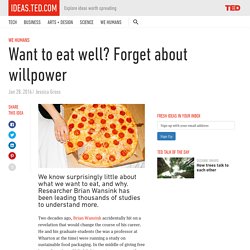
He and his graduate students (he was a professor at Wharton at the time) were running a study on sustainable food packaging. In the middle of giving free bags of snacks to Philadelphia moviegoers to see if they noticed they ate more from big packages, they ran out of big bags and had to revert to teeny ones that held just 110 calories. And here’s what they found: People with four tiny bags ate half as much as those with one big 440-calorie bag — and said they’d pay 20 percent more for snacks if companies sold them in smaller packages. “So here’s the punch line,” he says: “You can make more money by selling less food.” Since then, Wansink — now a professor of applied economics and management at Cornell, director of the Cornell Food and Brand Lab, and author of books including Slim by Design — has run 1,200 studies, by his estimate, on eating behaviors. Size matters. Color matters. This is how our bodies betray us in a lie.
Let me start with a question: How do you know if a person is lying?
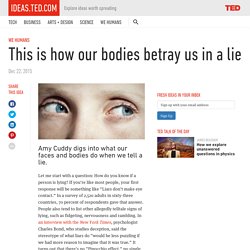
If you’re like most people, your first response will be something like “Liars don’t make eye contact.” In a survey of 2,520 adults in sixty-three countries, 70 percent of respondents gave that answer. People also tend to list other allegedly telltale signs of lying, such as fidgeting, nervousness and rambling. In an interview with the New York Times, psychologist Charles Bond, who studies deception, said the stereotype of what liars do “would be less puzzling if we had more reason to imagine that it was true.” It turns out that there’s no “Pinocchio effect,” no single nonverbal cue that will betray a liar.
When we are being inauthentic — projecting a false emotion or covering a real one — our nonverbal and verbal behaviors begin to misalign. This idea is not exactly new. Simply put, lying — or being inauthentic — is hard work. Simply put, lying — or being inauthentic — is hard work. Lying and leaking go hand in hand. How language can affect the way we think. Keith Chen (TED Talk: Could your language affect your ability to save money?)
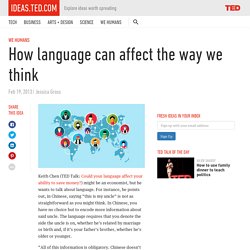
Might be an economist, but he wants to talk about language. For instance, he points out, in Chinese, saying “this is my uncle” is not as straightforward as you might think. In Chinese, you have no choice but to encode more information about said uncle. The language requires that you denote the side the uncle is on, whether he’s related by marriage or birth and, if it’s your father’s brother, whether he’s older or younger.
Michael Norton: How to buy happiness. Derek Sivers: How to start a movement. Neil Pasricha: The 3 A's of awesome. 7 lessons about finding the work you were meant to do. Emily Pidgeon Whether it was during a career aptitude test or in a heart-to-heart chat after getting laid off, chances are someone has talked to you about how to “find your calling.”
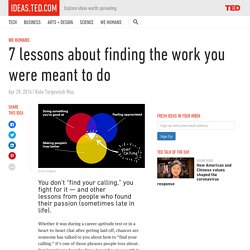
It’s one of those phrases people toss about. But StoryCorps founder Dave Isay takes issue with it … specifically, the verb. “Finding your calling — it’s not passive,” he says. “When people have found their calling, they’ve made tough decisions and sacrifices in order to do the work they were meant to do.” In other words, you don’t just “find” your calling — you have to fight for it. Over a decade of listening to StoryCorps interviews, Isay noticed that people often share the story of how they discovered their calling — and now, he’s collected dozens of great stories on the subject into a new book, Callings: The Purpose and Passion of Work. 1. 2. 3. 4. 5. 6. 7.
8 practical ways to help refugees. Melissa Fleming of the UN’s Refugee Agency shares some ways to help refugees right now.

When a million refugees showed up in Europe this past year, the world began to take notice of a problem that has been steadily growing before our eyes. Ten years ago, 38 million people had been driven from their homes because of war or persecution; right now that number stands at over 65 million. That’s equivalent to the population of France … drifting, stranded, with little hope of returning home, and few chances to thrive in neighboring countries. In Europe, the lack of a unified system to manage the influx of refugees and migrants is exacerbating the problem. How a great conversation is like a game of catch. Barry Lee When you play catch, you have to do an equal number of catches and throws, right?
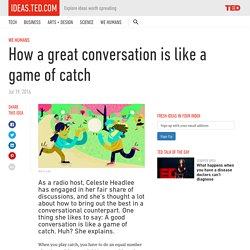
It’s not possible to play catch with somebody and throw more than you catch, for the most part. Because then you’d just be throwing baseballs at them, which is not nice. This is the exact same ratio as a healthy conversation — you’re going to catch as much as you throw. Which means, obviously, you’re going to talk 50% percent and listen 50% percent — and we don’t generally have that balance in our conversations. Chris Anderson: TED's secret to great public speaking. Mellody Hobson: Color blind or color brave? Adam Grant: The surprising habits of original thinkers. Linda Liukas: A delightful way to teach kids about computers. Hexagons! And other reasons to get excited about math.
Eduardo Sáenz de Cabezón suspects that when people ask him what’s the use of math, they’re really asking a more pointed question.

“They’re asking you, ‘Why did I have to study that bullshit I never used in my life again?’” He says. Sáenz de Cabezón (TED Talk: Math is forever) sympathizes, but as a mathematics professor at the University of La Rioja in northeastern Spain, he has come up with a spirited defense of his chosen profession. Math, he believes, is nothing less than a quest for eternal truth. Eduardo Sáenz de Cabezón: Math is forever. Carol Dweck: The power of believing that you can improve. Dan Meyer: Math class needs a makeover.
Gever Tulley: 5 dangerous things you should let your kids do. Margaret Heffernan: Forget the pecking order at work. Margaret Heffernan: Forget the pecking order at work.